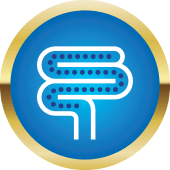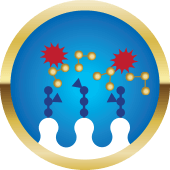Babies are born with an immature immune system that develops during the first few months of life. The mother protects her baby during this transition with components transferred in her breast milk, such as human milk oligosaccharides (HMOs).1
Human Milk Oligosaccharides
Did you know?
What are HMOs?
Breast milk contains protective immune factors, including human milk oligosaccharides (HMOs) such as 2'-FL, that help build baby’s developing immune system.2
HMOs are non-digestible carbohydrates that form the third most abundant solid component of breast milk.3,4
What is 2’-FL?
Of all the HMOs that have been identified in breast milk, 2’-fucosyllactose(2’-FL) is the most abundant and is found in the milk of most mothers.8
What do HMOs, like 2’-FL, do?
About 70% of the immune system is found in the digestive tract9, so maintaining a favourable environment for beneficial bacteria in the gut can help babies build strong digestive and immune systems.6 HMOs, like 2'-FL, in breast milk can affect the baby's immune system in various ways:6

FEED THE GOOD
BACTERIA IN THE
BABY’S GUT
(PREBIOTICS)

PROTECT AGAINST
HARMFUL
BACTERIAIN THE
BABY’S GUT

SUPPORT THE
BABY’S DEVELOPING
IMMUNE SYSTEM
Breast Milk-Inspired
Up until recently, 2'-FL was only available to breastfed babies. As a result of 25 years of breakthrough research, Similac® made 2'-FL† available to formula-fed babies with the launch of Similac Pro-Advance® Step 1 and Step 2.
The innovative ingredient 2'-FL† is now extended to: Similac Total Comfort® and Go & Grow by Similac® Step 3. We are very proud to bring Canada a full selection of infant formulas with 2'-FL† to meet the changing nutritional needs of your baby during their first years of life.
† Not derived from human milk.
References:
- Kulinich A, et al. Carbohydr Res. 2016;432:62‐70.
- Boix-Amorós A, et al. Nutr Rev. 2019;77(8):541-556.
- Jantscher-Krenn E, et al. Minerva Pediatr. 2012;64:83-99.
- Zivkovic AM, et al. Proc Natl Acad Sci. 2011;108(Suppl. 1):4653-4658.
- Castanys-Muñoz E, et al. Nutr Rev. 2013;71(12):773-789.
- Holmgren J, et al. Immunobiology. 1992;184(2-3):157-179.





